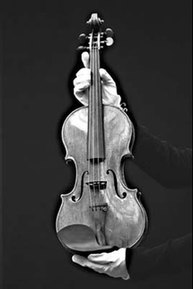Musicians must borrow, not buy, the rarest violins
Updated: 2013-04-07 07:45
By Corinna Da Fonseca-Wollheim (The New York Times)
|
|||||||||||
|
The market for violins like Stradivari is led by the great wealth of hedge funds and philanthropists. Lefteris Pitarakis / Associated Press |
The din inside the Metropolitan Pavilion in the Chelsea neighborhood of New York recently was that of any trade fair, except for the snippets of classical violin music that wove in and out of the roar of voices.
It was the opening day of Mondomusica New York, an offshoot of the biggest industry event in the string-instrument world, which for years has been held in Cremona. The violins that came out of that northern Italian city in the 17th and 18th centuries inscribed with names like Stradivari, Guadagnini and Guarneri del Gesu are still the most ardently coveted - but the market for them is now global.
Many of the visitors were musicians in search of a better instrument; professionals stole longing glances at the 18th-century treasures that dealers displayed in glass cases.
And a little prayer may well be required for a violinist to possess one of these. With the price of a Strad at $2 million to $18 million, the market is now dominated by philanthropists, foundations and hedge funds.
"Players' salaries are so low, and the price of instruments so high, they've skyrocketed out of sight of musicians," said Christophe Landon, who has restored, sold and appraised rare instruments for more than four decades.
Most often soloists rely on the generosity of a wealthy owner or foundation to lend them an instrument. When an institution purchases one, it is unlikely to enter the market again, leading to an ever-shrinking pool of available instruments. Add to that the growing number of concert soloists coming out of Chinese and South Korean conservatories, and prices are guaranteed to rise.
In 2011 the Nippon Music Foundation, which has built up a collection of more than a dozen first-rate instruments that it lends to musicians, sold the Lady Blunt Stradivari - which had changed hands in 1971 for $200,000 - for $15.9 million. More recently, an anonymous buyer purchased, for the use of the violinist Anne Akiko Meyers, the Vieuxtemps Guarneri del Gesu, up for sale for $18 million, for an undisclosedfigure that was said to be a record.
Such rare instruments are an attractive proposition to investors. Mr. Landon is a partner in the Artist Rare Instrument Fund, a hedge fund that plans to buy not only Strads, but also shares in valuable violins or cellos owned by soloists who agree to sell a portion of their equity in their instruments to the fund.
Kerry Keane, international specialist head of musical instruments at Christie's, said there were certain factors that make any collectible a good long-term investment, chief among them doubt-free attribution, quality and good condition , though also issues of provenance, an object's freshness to the market and, to a lesser degree, fluctuations in fashion.
"What makes a rare violin different from other collectibles," Mr. Keane said, "is the synergy that comes out of placing it in the hands of a wonderful artist."
He added, "Without that, you are just dealing with a sculpture that happens to look like a violin."
The New York Times
Today's Top News
Police continue manhunt for 2nd bombing suspect
H7N9 flu transmission studied
8% growth predicted for Q2
Nuke reactor gets foreign contract
First couple on Time's list of most influential
'Green' awareness levels drop in Beijing
Palace Museum spruces up
Trading channels 'need to broaden'
Hot Topics
Lunar probe , China growth forecasts, Emission rules get tougher, China seen through 'colored lens', International board,
Editor's Picks

|

|

|

|

|

|






